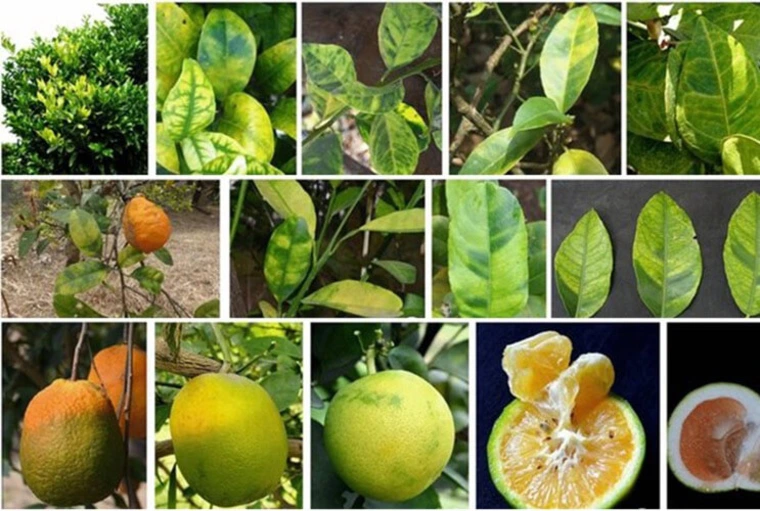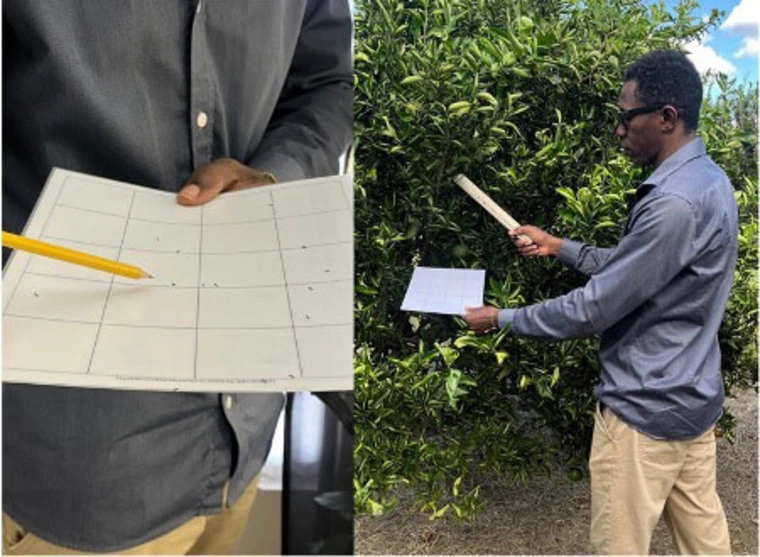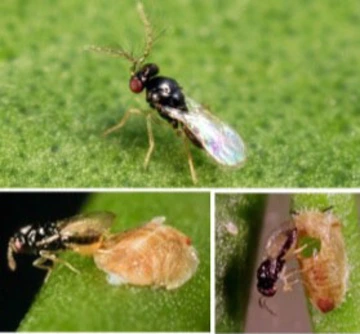The Asian citrus psyllid (ACP), Diaphorina citri, is a major pest of citrus trees that spreads citrus greening disease, also known as Huanglongbing (HLB), the most destructive citrus disease in the world. HLB has already devastated Florida’s citrus industry and continues to threaten citrus-growing areas across the country. Unfortunately, there is no cure for HLB. Once a tree is infected, it may become weak and unproductive and must be removed to prevent the disease from spreading. ACP was first detected in San Luis, Arizona, in 2009 and has since spread to all citrus-growing areas of the state, resulting in a statewide quarantine. In January 2025 HLB was confirmed in residential citrus trees in Nogales, Arizona for the first time. This is a serious warning that Arizona’s citrus industry is at risk. Thus, everyone involved in the Arizona citrus industry must act now to help prevent the spread of this destructive disease.
Identification and biology of Asian citrus psyllid
Egg
Females begin laying eggs about 12 days after mating. They deposit tiny yellow-orange, almond-shaped eggs in the folds of the youngest, soft leaves, known as the “feather flush” (Figure 1A). A single female can lay hundreds of eggs under favorable conditions. Eggs hatch within a few days to weeks, depending on temperature.
Nymph
The immature stage, called nymphs, develops only on tender new growth. Nymphs are flat, slow-moving, and tend to cluster together. They often produce curled white clusters of waxy filaments, which can be a visible sign of their presence (Figures 1B and 1C). Nymph development includes five stages, lasting up to a month before reaching adulthood.
Adult
The adult ACP is a tiny insect, only 2-3 millimeters long. Adults are mottled brown and gray, with wings held like a roof over their body. They jump when startled and adopt distinct tail-up, head-down posture when feeding (Figure 1D). They reproduce quickly and can be present year-round, especially during spring and summer when new growth is available. Their life cycle lasts from two to seven weeks, meaning many overlapping generations can develop in a single year. Warm temperatures (25-30°C) and moderate humidity favor faster growth and higher survival.
Adult psyllids typically fly short distances but may occasionally travel several miles in search of host plants. However, their ability to disperse can be significantly affected by temperatures above 40°C, which is similar to the temperatures observed in Arizona. They mainly feed on citrus species such as orange, lime, lemon, tangerine, and grapefruit. They can also survive on ornamental plants related to citrus, particularly orange jasmine (Murraya) and, occasionally, other plants such as figs.

Figure 1. Morphological stages in the life cycle of Asian citrus psyllid.(A) Almond-shaped egg. (B, C) Nymphal instars exhibiting waxy filaments. (D) Mottled adult.
M. Lewis, Center for Invasive Species Research, UC Riverside
Impacts on citrus growth and health
ACP harms citrus trees in two ways: 1) Direct damage occurs when the insect feeds and releases honeydew. This sticky substance encourages the growth of black sooty mold and white waxy clusters on plants (Fig ure 2). As a result, young shoots may curl, weaken, and drop leaves, reducing overall plant growth and flowering. 2) Indirect damage is more serious. While feeding, psyllids can transmit the bacterium that causes HLB, a deadly citrus disease. It only takes a few psyllids to infect a tree, leading to stunted growth with yellow shoots and mottled leaves (asymmetrical leaf chlorosis, which can resemble mineral deficiencies), bitter or misshapen fruit, fruit drop, and eventually tree death (Figure 3).

Figure 2. Black sooty mold and waxy clusters on citrus leaves (Left), and ACP-associated waxy filament deposition with shoot curling (Right).
Michael Rogers, University of Florida

Figure 3. Diverse symptoms of HLB on citrus, including yellow shoots, leaf discoloration, and fruits showing stylar-end greening and misshaping.
Ashis Das, National Research Centre for Citrus, Nagpur.
Scouting for Asian citrus psyllid and citrus greening
To scout for ACP and HLB, inspect citrus trees every 1-2 weeks, focusing on the new flush where all stages, eggs, nymphs, and adults are found. Nymphs and adults of Asian citrus psyllid can be detected by visually inspecting tender shoots and by placing yellow sticky cards across the groves, respectively. Eggs and nymphs are restricted to young growth; therefore, careful observation of unfolding leaves is essential. A practical approach is to examine at least two leaf flushes per tree, looking for adults at a 45° angle on stems and nymphs producing white waxy threads or honeydew. Tap sampling is the most efficient method used to monitor ACP adults. For this method, a laminated sheet of letter-sized paper or any smooth white surface, such as a clipboard, can be utilized. Another necessary tool is a 1-foot piece of one-half-inch or three-quarter-inch PVC pipe. The laminated sheet should be placed approximately 1 foot below the leafy branch, and the branch is struck three times with the pipe to dislodge any ACP present (Figure 4). Subsequently, the dislodged ACP are counted and recorded. It is recommended to take 10 visual samples (for nymphs) and 10 tap samples (for adults) per location for a total of no less than 10 locations per citrus block, with 5 around the borders where psyllids tend to congregate and 5 in the interior of the block.
Because ACP and HLB can be difficult to identify without training, any suspicious findings should be reported immediately to the Arizona Department of Agriculture or your local county Extension office. Do not attempt to collect or ship insects or plant material, as this can risk spreading the pest or disease. Instead, take clear photographs of the insect or plant symptoms and include the location when reporting.

Figure 4. Dr. Romain Exilien collecting a sample (right) and the appearance of psyllids on a white laminated sheet (left).
Adnise S. Christophe, University of Florida– IFAS North Florida Research and Education Center
Limiting spread
To protect citrus trees from ACP and HLB, follow these key practices:
- Do not transport citrus fruit, plants, or leaves from outside of Arizona into the state without a permit. This is against Arizona law.
- Inspect your trees regularly. Look for symptoms such as curling shoots, waxy nymph clusters, mottled yellowgreen leaves, or stylar end greening or blotchy mottled fruit. Early detection is critical.
- Control the psyllid population. Use effective control methods such as natural enemies, horticultural oils, soaps, or pesticides recommended by local agricultural authorities.
- Maintain strong, healthy trees. Provide proper watering, fertilization, and weed management to increase the tree’s tolerance to stress.
- Report suspicious cases. If you suspect HLB symptoms, notify the Arizona Department of Agriculture so a regulatory sample can be collected.
If appropriate agricultural practices are implemented, clean plants are purchased, the psyllids are managed, and diseased trees are removed and properly disposed of, we can help protect citrus trees and reduce the spread of this devastating disease.
Control in organic and conventional production
Controlling ACP is a key challenge for both conventional and organic citrus growers. Some practices can be implemented in both conventional and organic production, but other strategies and tools are restricted to only conventional production systems. Below are some strategies that can be implemented to manage ACP
Organic-allowed management tactics
Synthetic pesticides are prohibited in organic citrus production; thus, growers rely heavily on organically derived pesticides as well as non-chemical methods that protect beneficial insects and the environment. Biological control agents play a crucial role in suppressing ACP populations. One of the most studied beneficial insects is a tiny wasp called Tamarixia radiata, which lays its eggs on young psyllid nymphs (Figure 5). When the wasp larvae develop, they kill the psyllid. Tamarixia is more effective during cooler months, and organized releases by state and federal agencies have helped reduce ACP populations in several citrus-growing regions, including Arizona. However, the extreme summer heat in the Arizona desert interrupts ACP development, which has limited both the establishment and impact of T. radiata. Since Tamarixia is not commercially available to growers, conserving natural enemies by minimizing pesticide use remains the most practical way to enhance biological control. Other natural enemies include lady beetles, lacewings, spiders, syrphid flies, and minute pirate bugs. Together, these predators can destroy 70-90% of psyllid eggs and nymphs in regions where ACP is established. While their effects on ACP are not well documented in arid citrus-growing regions, growers can encourage these beneficial insects by reducing pesticide use, planting flowering plants nearby for nectar and shelter, and controlling ants that protect psyllids in exchange for honeydew.
For direct control, biopesticides, including neem-based products (azadirachtin, and neem oil), and horticultural oils, provide effective, low-toxicity options for managing ACP in organic citrus production. These contact insecticides target ACP eggs and nymphs on young shoots by smothering them and are most effective with thorough coverage of new growth. Because they leave no harmful residues and break down quickly, they pose minimal risk to pollinators, humans, pets, and beneficial insects, making them ideal for early-season applications before natural enemies are established. Horticultural oils with 97%+ petroleum content, such as FC 435-66 and FC 455-88, can be safely applied as needed but should not be used when temperatures exceed 94°F to avoid plant damage. Regular monitoring is key; if natural enemies become abundant, further spraying should be avoided to support biological control.
Spinosad
Spinosad is a microbial-derived insecticide that offers effective control of ACP by penetrating leaf tissue, allowing contact with hidden nymphs. It is effective for about a week and can harm pollinators and other sensitive beneficial arthropods if applied in bloom or during peak activity periods. To mitigate harm, time applications during evening hours or when pollinators are inactive and monitor predator activity before reapplying.
Pyrethrins
Pyrethrins are fast-acting, broad-spectrum insecticides that can help growers manage ACP. They should be used carefully and rotated with other products to prevent resistance. For best results, spray the foliage every 7-10 days during new leaf flushes, covering the undersides of leaves where psyllids often hide. While this treatment can reduce both adults and nymphs, it may also harm beneficial insects, including bees. To minimize risks to pollinators, apply pyrethrins late in the day or in the evening, and avoid spraying during bloom whenever possible.
Kaolin clay
Kaolin clay is another valuable organic tool for managing ACP. When applied to citrus foliage, it forms a thin white film that acts as a physical barrier, deterring psyllids from landing, feeding, and laying eggs. The coating also irritates the insects, reducing their activity and reproduction. Kaolin is safe for humans, animals, and beneficial insects, making it a practical option for organic and eco-conscious commercial growers. Regular applications can help suppress ACP populations and lower the risk of HLB spread. However, new leaf flush does not retain the coating, leaving fresh growth unprotected. For best results, kaolin should be rotated with other organic controls, such as horticultural oils, and used in conjunction with consistent monitoring.

Figure 5. Adult Tamarixia radiata on a leaf (top), female T. radiata parasitizing a psyllid nymph (bottom left), and adult T. radiata emerging from a parasitized psyllid nymph (bottom right).
Top image Lyle Buss, UF/IFAS and bottom images Mike Lewis, UC Riverside
Conventional insecticide control
Synthetic insecticides remain the most widely adopted strategy for managing ACP in conventional citrus production. Growers have access to a range of synthetic insecticides that provide fast and reliable suppression. However, their use must be carefully managed to minimize harm to beneficial insects and slow the development of resistance.
Soil-applied systemic insecticides, especially neonicotinoids, offer long-lasting protection. These are particularly effective in young, nonbearing trees, where root uptake allows for efficient distribution throughout the plant. The most commonly used active ingredients include imidacloprid, thiamethoxam, and clothianidin (Group 4A), along with cyantraniliprole (Group 28).
Imidacloprid is especially effective against ACP nymphs. When applied as a soil drench near the tree base, it is absorbed by the roots and moves into new growth where psyllids feed. The insecticide remains in the plant for up to six months, though peak efficacy typically lasts one to three months. For best results, apply once per year in summer or early fall, just before or during leaf flush. Since uptake takes one to two weeks, proper timing is critical. Imidacloprid is toxic to bees, thus it should be applied in early fall when citrus trees are not blooming to minimize risks to pollinators. Avoid applications during flowering periods to protect bee populations.
Soil drenches should be applied directly at the base of citrus trees, ideally using a calibrated applicator that delivers 8-10 oz of solution per tree. Seasonal use restrictions apply to prevent overuse. For imidacloprid, the maximum allowed is 0.5 lb. of active ingredient per acre per season. Thiamethoxam (Platinum 75 SG) is limited to 0.172 lb. of active ingredient per acre. Clothianidin (Belay 50 WDG) is only approved for nonbearing trees and is restricted to 0.4 lb. of active ingredient per acre. Always follow label directions to ensure effectiveness and reduce risks to beneficial insects and the environment.
In bearing trees, foliar sprays targeting adult psyllids are most effective when applied before the spring flush. Once psyllids begin reproducing on new growth, populations can increase rapidly and become more difficult to manage. Early applications of pyrethroids (Group 3A) or organophosphates (Group 1B), during late winter can suppress overwintering adults and reduce ACP pressure during active growth periods. This strategy also limits the need for treatments during bloom, protecting pollinators.
To maintain long-term effectiveness, growers should integrate chemical control with other proven strategies, including biological control, biopesticides, and regular monitoring. Rotating insecticide modes of action throughout the season is essential to delay resistance. Supporting natural enemies, minimizing unnecessary applications, and applying insecticides based on pest thresholds can enhance control while preserving beneficial insect populations. Currently,there is no fixed action threshold for ACP. Due to its role as a vector of HLB, there is no guaranteed protection against even a single psyllid. However, in California, a threshold of ≥20% infested flushes is suggested.
Cultural control
There are no documented cultural practices for ACP management in arid citrus-growing regions like Arizona.
Summary
Citrus growers are essential to protecting Arizona’s citrus industry from the spread of HLB. Consistent monitoring for ACP and early disease symptoms, combined with timely and effective management practices, can significantly reduce the risk of infection. Reporting infected trees to the appropriate authorities and following recommended control strategies can help prevent the spread of both the vector and the disease. Cooperation of growers and pest control advisors is vital; HLB management is most successful when efforts are coordinated across regions. By staying informed and proactive, we can help preserve the health, productivity, and future of citrus groves across the state. Your actions make a lasting impact.
References
Arizona Department of Agriculture. 2025. Citrus Greening Disease Detection – Nogales, AZ. [accessed 26 Aug 2025]. https://agriculture.az.gov/news/press-release-citrusgreening-disease-detection-nogales-az-01282025 Arizona Department of Agriculture. 2025.
Asian Citrus Psyllid. [accessed 23 Aug 2025]. https://agriculture.az.gov/pestspest-control/agriculture-pests/citrus-pests/asian-citrus-psyllid Antonilez, CA, Moyneur T, Martini X, and Rivera MJ. 2021.
High Temperatures Decrease the Flight Capacity of Diaphorina citri Kuwayama (Hemiptera: Liviidae). Insects. https://doi.org/10.3390/insects12050394
Diepenbrock LM, Qureshi J, Stelinski LL. 2025. Florida Citrus Production Guide: Asian Citrus Psyllid. Ask IFAS - Powered by EDIS. [accessed 2025 Sept 4]. https://edis.ifas.ufl.edu/publication/CG097
Exilien, R, Qureshi JA, & Martini X. 2025. Evaluation of Repellent Effects of Plant-Based Essential Oils, Red Dye, and Kaolin on Asian Citrus Psyllid. Entomologia Experimentalis et Applicata 173 (3): 260–69. https://doi.org/10.1111/eea.13541
Gomez-Marco F, Gebiola M, Baker BG, et al. 2019. Impact of the Temperature on the Phenology of Diaphorina citri (Hemiptera: Liviidae) and on the Establishment of Tamarixia radiata (Hymenoptera: Eulophidae) in Urban Areas in the Lower Colorado Desert in Arizona. Environ Entomol. 48(3):514–523. https://doi.org/10.1093/ee/nvz048
Kabashima, JN, Paine T, Daane K, et al. 2014. Psyllids Management Guidelines. [accessed 2025 Sept 4]. https://ipm.ucanr.edu/PMG/PESTNOTES/pn7423.html
Michaud JP. 2004. Natural mortality of Asian citrus psyllid (Homoptera: Psyllidae) in central Florida. Biological Control. 29(2):260–269. https://doi.org/10.1016/S1049-9644(03)00161-0
Stansly, P., A. Arevalo, and J. Qureshi. Monitoring methods for Asian citrus psyllid. [accessed 9 Sept 2025]. https://swfrec.ifas.ufl.edu/hlb/database/pdf/00001942.pdf
UC IPM. 2024. Asian Citrus Psyllid / Citrus / Agriculture: Pest Management Guidelines / UC Statewide IPM Program (UC IPM). [accessed 4 Sept 2025]. https://ipm.ucanr.edu/agriculture/citrus/asian-citrus-psyllid/#gsc.tab=0
USDA Animal and Plant Health Inspection Service. 2025. Citrus Greening and Asian Citrus Psyllid. [accessed 27 Aug 2025]. https://www.aphis.usda.gov/plant-pestsdiseases/citrus-diseases/citrus-greening-and-asiancitrus-psyllid
USDA Animal and Plant Health Inspection Service Plant Protection and Quarantine. 2019. Asian Citrus Psyllid Biological Control Release Program. [accessed 3 Sept 2025]. https://www.aphis.usda.gov/sites/default/files/fsc-acp-biocontrol-b.pdf
Wright, GC and GJ Caravetta. 2014. Response of Government and the Citrus Industry to the Discovery of Asian Citrus Psyllid in Arizona. Journal of Citrus Pathology. https://escholarship.org/uc/item/0220d3dj

